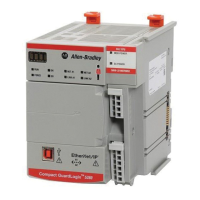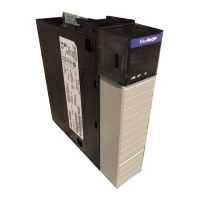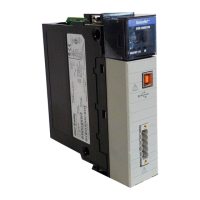260 Rockwell Automation Publication MOTION-RM003I-EN-P - February 2018
If the drive is configured for Velocity Loop operation the following
calculations apply:
Velocity Loop Bandwidth = System Bandwidth
Velocity Integer Bandwidth = 0.25/Damping Factor
2
* System Bandwidth
Velocity Error Tolerance = 2 * max(Max Accel, Max Decel) / Velocity Loop
Bandwidth (rad/s)
• Load Observer Configuration
If the Load Observer Configuration setting indicates the observer function
is enabled, the following calculations are performed:
Load Observer Bandwidth = Velocity Loop Bandwidth
• Gain Tuning Configuration
If the Gain Tuning Configuration bit for Tune Torque LP Filter is set, the
following calculation is performed:
Torque LP Filter BW = 5 * Velocity Loop BW.
The System Bandwidth value can also be updated through a Set service to the
Position Servo Bandwidth or Velocity Servo Bandwidth attributes depending on
Axis Configuration. If configured for Position Loop, System Bandwidth is
updated by a set to Position Servo Bandwidth. If configured for Velocity Loop,
System Bandwidth is updated by a set to Velocity Servo Bandwidth. When derived
from either of these attributes, no calculations are performed; the System
Bandwidth attribute value is simply updated.
A Set or SSV to the System Bandwidth attribute also updates Position Servo
Bandwidth or Velocity Servo Bandwidth attributes depending on Axis
Configuration. If configured for Position Loop, the Position Servo Bandwidth is
updated. If configured for Velocity Loop, Velocity Servo Bandwidth is updated.
Damping Factor
Usage Access T Data
Type
Default Min Max Semantics of Values
Required - PV Set/SSV
REAL FD 0.5 2.0 -
The Damping Factor attribute value is used in calculating the maximum Position
and Velocity Servo Bandwidth values during execution of the Motion Run Axis
Tune (MRAT) instruction. In general the Damping Factor attribute controls the
dynamic response of the drive axis. When gains are tuned using a small damping
factor (such as 0.7), a step response test performed on the axis would demonstrate
under-damped behavior with velocity overshoot. A gain set generated using a

